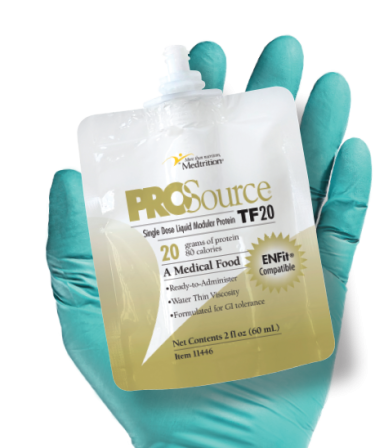As clinicians we often assume that if a product has a high osmolality it automatically means the product or formula will be poorly tolerated. It is important to recognize the difference between osmolality of a modular protein product and the osmolality of a modular protein product with a high concentration of sugar alcohol and/or simple carbohydrate. High osmolality does not automatically mean poor tolerance when discussing the tube fed population although they do tend to be synonymous. The terms have been incorrectly used interchangeably in the nutrition support community because of a lack of understanding and a general association that all modular proteins are the same. Osmolality is a simple measure of particles in a solution. Osmolality can be elevated when amino acids are added to a product. This is not an automatic means for gi distress. In fact the ASPEN core curriculum states:
Osmolality of an enteral formulation is the concentration of free particles, molecules, or ions in a given solution, and it is expressed as milliosmoles per kilogram of water. Formulas containing sucrose have a higher osmolality than those with cornstarch or maltodextrin and formulas with single amino acids or high amounts of di or tripeptides have a higher osmolality than those with intact proteins.
When hyperosmolar formulations containing sucrose are delivered directly into the small intestine, dumping syndrome can occur, but this problem is unlikely to occur when peptide or single amnio acids are provided in a similar manner. However, other than simple sugar- related hyperosmolality, the osmolality of an enteral formulation has little to do with formula tolerance (1).
Please note there is no sugar, added sugar or source of carbohydrate in ProSource® TF or ProSource® TF20 products. These products were designed specifically for good GI tolerance and with the absence of glycerin (a sugar alcohol added to many modular proteins.) The addition of this specific ingredient is commonplace in the modular protein community and unfortunately the reason why GI distress is so common with modular protein as well. Glycerin also increases the osmolality of a product. Glycerin as you are likely already aware, is also used for its laxative effects to help manage constipation and bowel irregularity. Medtrition does not use glycerin as an ingredient in any of our liquid protein products for that reason.
Our goal at Medtrition is to be part of the solution not the problem. Please keep in mind that, especially in the enteral fed population, Medtrition is the only company in the USA with a modular protein product specifically designed for the enteral population.
For more information about ProSource TF and ProSource TF20 visit our webpages HERE and HERE
Mueller, C., Lord, L. M., Marian, M., McClave, S., & Miller, S. J. (2017). The Aspen Adult Nutrition Support Core Curriculum. American Society for Parenteral and Enteral Nutrition. Pg 230-231.